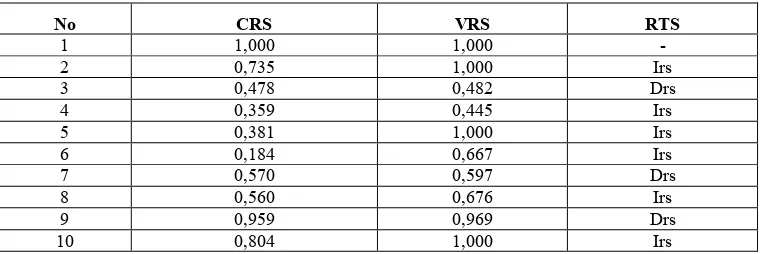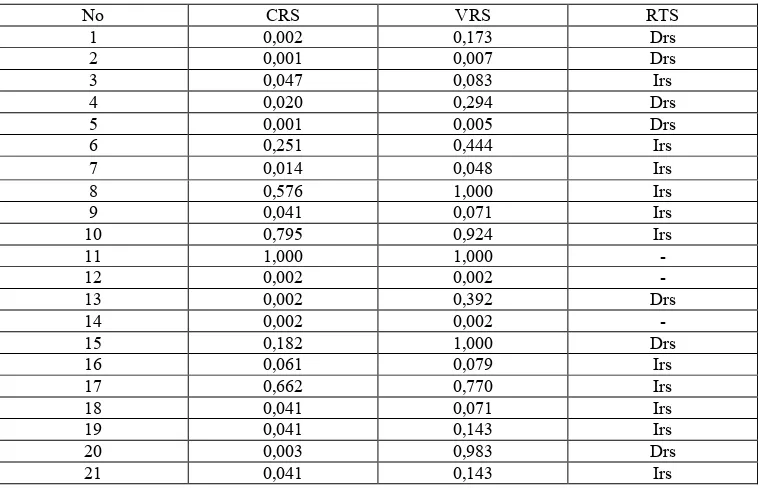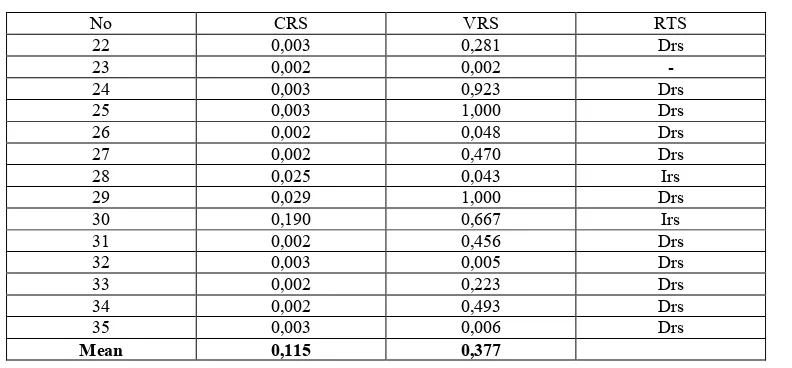Technical efficiency of pesticide application on
tomato, chinese cabbage and cauliflower in
simpang empat sub-district Karo Regency
Sri Fajar Ayu1* and Destanul Aulia2
1Faculty of Agriculture, Universitas Sumatera Utara, Medan, Indonesia 2Public Health Faculty, Universitas Sumatera Utara, Medan, Indonesia
Abstract. Prior research by authors on the use of pesticides and their impact on 75 vegetable farmers in Simpang Empat subdistrict, Karo district, North Sumatra showed that 60% of respondents applied pesticides in excess of the packaging instructions. Respondents were also found not to use a complete protective device. Almost 70% of respondents have mild toxicity complaints, and based on blood cholinesterase levels are also found most respondents have mild toxicity. Pesticide residue test results also found 0.728 residues of chlorpyrifos and 0.321 profenofos in vegetables produced in this area. This led to continued review by checking the technical efficiency in the use of pesticides. The method used is a quantitative method with the Data Envelope Analysis (DEA) approach to analyze technical efficiency of pesticide on each commodity. The population is the whole vegetable farmer who grew tomatoes, Chinese cabbage and cauliflower at the time of the study. The entire population is used to be a sample of 35 tomato and cauliflower farmers and 20 Chinese cabbage farmers. The results of the study indicate that the uses of pesticide as production inputs on tomato commodities, Chinese cabbage and cauliflower are not technically efficient. It is suggested to farmers to use pesticide input according to the rules, proper dosage, on target, on time, the right way so that pesticide used is technically efficient.
1 Introduction
The current pattern of pesticide use by farmers is a problem. There are many farmers, who use pesticides are incompatible with the recommended dosage and procedure, resulting innegative impacts on the economy and the environment. According to Lakitan (1995), the pesticide application can cause disturbance to the stability and balance of ecosystem. Secondary pest explosion is one of a side effect of pesticide use. The diversity of species is also sometimes reduced as a negative impact of pesticide use. Applications of pesticides can contaminate the physical environment, including soil and water. In addition, the unwise use of pesticides also directly affects farmers' income. Where the current prices of pesticides are quite expensive, and this will certainly affect the cost of production of
farmers. The fact that the rising cost of production is not always offsetted by the increased income of farmers. And this leads to inefficiency in vegetable farming in Karo District.
One of the areas in Karo Regency which became the largest horticulture producer is Simpang Empat Sub-district. In 2016, Simpang Empat Sub-district produced 10,090 tons of cabbage flowers, 8,778 tons of petsai and 9,870 tons of tomatoes [1]. Efforts to increase horticulture production continue to be done in line with the increasing demand due to population growth. These efforts are intensification and extensification programs recommended by the government. On a farmer scale, increased technical production is more inclined towards superior seed selection, planting techniques and pesticides management techniques. Scientific studies have shown that the use of pesticides may increase farm production. Increased production will have an impact on the increase in income received by farmers in every harvesting activity [2, 3, 4, 5, 6].
Increased pest attacks or plant pest organisms become one of the reasons farmers adopt pesticide application techniques that are incompatible with established standards doses on pesticide packaging. The use of excessive doses results in the presence of pesticide residues attached to horticultural products, soil and water. All pesticide chemicals in general inhibit the important metabolic processes of an organism [7]. Therefore, pesticides are considered to be toxic compounds. This statement should be a concern, especially for vegetable consumers to do right action before consuming vegetables and fruits.
Pesticide residue test conducted on samples of tomato plants, Chinese cabbage and cauliflower obtained from the study area showed varying results. The test results can be seen in the following table:
Table1. Results of Pesticide Residue Test Using Gas Chromatography
Plant Names
Weight Pesticide Working System
*Laboratory of BPTPH Sumatera Utara 2017
Testing of pesticide residues in chinese cabbage showed different results with the cauliflower. Chinese cabbage showed positive results of pesticide residues. The residue detected was Klorpirifos of 0.728 mg/kg, with the maximum limit of residual (BMR) of 1 mg/kg (as determined by the Agriculture Service of Sumatra Utara), it was seen that the detected residue had almost reached BMR. However, the chinese cabbage which become the sample of research still save to be consumed. The pesticide residue present in the vegetable can be reduced by giving the treatment of doused with clean running water and washed with detergent or vegetable soap. The next vegetable is tomato (Solanum lycopersicum) which also positively contains pesticide residues. The material detected through the test is Profenofos as much as 0.321 mg/kg, with the pesticide residue limits (BMR) of 10 mg/kg then the tomato being sampled in this study is still classified in the category of save for consumption.
nt ght ticide king e rge ot/ e R*
li Kg an ct fos 125 6 ion
ese 5 Kg tracol ct neb 175 7 fos
mato 6 Kg an ct fos 175 10 nofos
also be done using technical efficiency calculations. Increased production through technical efficiency is now an important alternative, because it can add to the potential production that is available to vegetable farmers. This study was aimed to analyze the technical efficiency of pesticide use in tomato, Chinese cabbage and cauliflower.
2 Method
This study was conducted with quantitative methods, namely technical efficiency analysis of pesticide on tomato, Chinese cabbage and cauliflower. Data analyzed using the Data Envelopment Analysis (DEA) approach. Primary data will then be processed with the help of Microsoft Excel and DEAP. DEA method is a job evaluation tool that requires one or more kinds of inputs and produces one or more output types. In a simple way, the measurement is expressed by the ratio of output to the input which is the unit of measurement of efficiency or productivity, which can be expressed partially (Cooper et al., 2006). The DEA approach uses fixed weighting across all inputs and outputs of each evaluated DMU. The DEA Variable Return to Scale model approach is more appropriate to be used in this study because the farming of tomatoes, Chinese cabbage and cauliflower at the research sites barely reaches the optimal scale. The assumption of this model is that the ratio between input and output additions is different (variable return to scale). That is, the change in input and output of a DMU takes place in a linear manner, allowing increased (increasing returns to scale) and decreasing (decreasing returns to scale) value of pesticide input efficiency in each commodity. The population is the whole vegetable farmer who grew tomatoes, Chinese cabbage and cauliflower at the time of the study. The entire population is used to be a sample of 35 tomato and cauliflower farmers and 20 Chinese cabbage farmers.
3 Result and Discussion
Technical efficiency is a combination of capacity and ability of an economic unit to produce up to the maximum output level of input quantities and technologies. The results of calculations on the technical efficiency of pesticide input use in tomatoes are as follows:
Table2. Technically Efficient of Tomato
No. CRS VRS RTS
1 0,001 0,001 Drs
2 0,000 0,001 Drs
3 0,000 1,000 Drs
4 0,001 0,002 Drs
5 0,001 0,001 Irs
6 0,000 0,001 Irs
7 0,000 0,001 Irs
8 0,000 0,001 Drs
9 1,000 0,001 Drs
10 0,000 1,000 -
11 0,000 0,001 Irs
12 0,000 0,002 Drs
13 0,000 0,001 Drs
14 0,000 0,000 Drs
15 0,000 0,001 Drs
16 0,000 0,000 Drs
No. CRS VRS RTS
18 0,000 0,001 Drs
19 0,000 0,001 -
20 0,000 0,001 Drs
21 0,000 0,001 Drs
22 0,000 0,001 Drs
23 0,000 0,001 Drs
24 0,000 0,001 Drs
25 0,000 0,001 -
26 0,000 0,000 Drs
27 0,000 0,001 Drs
28 0,000 0,001 Drs
29 0,000 0,001 Drs
30 0,000 0,001 -
31 0,000 0,001 Drs
32 0,000 0,001 Drs
33 0,000 0,001 Drs
34 0,000 0,001 Drs
35 0,000 0,001 Drs
Mean 0,029 0,058
Table 2 shows that the efficiency of pesticide use in tomatoes with Constant Return to Scale (CRS) assumption is 0,029. The technical efficiency value shows that the average sample can reach 0,29%. The average efficiency of pesticide the assumption of CRS is
0.029 ≤ 1 which means that the use of pesticide input in tomato plants is not efficient from
a technical point of view. The analysis showed that 34 farmers (97, 14%) were technically inefficient in return for Scale (CRS) and only 1 farmer (2.86%) were technically efficient in the use of pesticide in tomatoes. From the results obtained only DMU 9 has an efficient value of 1,000. While using the assumption of Variable Return to Scale (VRS) obtained the average value of technical efficiency of 0.058, technical efficiency value indicates that the average sample can reach 0.58%. The average efficiency of pesticide use using VRS
assumption is 0.058 ≤ 1 which means that the use of pesticide input in tomato plants is not
efficient from technical point of view. Calculation of analysis with Variable Return to Scale (VRS) resulted in 33 inefficient farmers (94.28%) and only 2 farmers (5.72%) technically efficient in the use of pesticides in tomatoes. So, it can be concluded for tomatoes, only one farmer (2, 86%) found technically efficient by CRS and two farmers (5, 72%) efficient by VRS. This implies that a large number of respondents face serious problems in terms of technical efficiency.
Table 3. Technically Efficient of Chinese Cabbage
No CRS VRS RTS
1 1,000 1,000 -
2 0,735 1,000 Irs
3 0,478 0,482 Drs
4 0,359 0,445 Irs
5 0,381 1,000 Irs
6 0,184 0,667 Irs
7 0,570 0,597 Drs
8 0,560 0,676 Irs
9 0,959 0,969 Drs
0.029 ≤ 1 which means that the use of pesticide input in tomato plants is not efficient from
assumption is 0.058 ≤ 1 which means that the use of pesticide input in tomato plants is not
No CRS VRS RTS
11 0,523 0,537 Drs
12 0,161 0,556 Drs
13 0,459 0,800 Drs
14 0,708 0,720 Drs
15 0,666 1,000 Drs
16 0,654 0,804 Irs
17 0,611 0,619 Drs
18 0,924 1,000 Drs
19 0,851 0,869 Drs
20 0,116 0,381 Drs
Mean 0,585 0,756
Table 3 shows that at the average efficiency of pesticide used in Chinese cabbage using the assumption of Constant Return to Scale (CRS) is 0,585. The technical efficiency value indicates that the average of sample can reach 0, 585%. The average efficiency of pesticide
use using the assumption of CRS is 0,585 ≤ 1 which means that the use of pesticide input is inefficient from technical point of view. The analysis showed Constant Return to Scale (CRS) as much as 19 farmers (95%) are technically inefficient and only 1 farmer (5%) is technically efficient. While using the assumption of Variable Return to Scale (VRS), the mean value of efficiency of 0.756 indicates that the average sample can reach 7.56%. The
average efficiency of pesticide use VRS assumption is 0.756 ≤ 1, which means that the use
of pesticide input on mustard is inefficient from technical point of view. Calculation of analysis with Variable Return to Scale (70%) found 6 farmers (30%) were technically efficient in the use of pesticides, which is the farmer or DMU samples 1,2,5,10,15 and 18 with value of 1,000. So, it can be concluded that only 1 farmer (5%) efficient by CRS and 6 farmers (530%) efficient in VRS. This implies that a large number of respondent's farmers face serious problems in terms of technical efficiency. The technical efficiency value of pesticide use on the cauliflower is presented in Table 4.
Table 4. Technically Efficient of Cauliflower
No CRS VRS RTS
1 0,002 0,173 Drs
2 0,001 0,007 Drs
3 0,047 0,083 Irs
4 0,020 0,294 Drs
5 0,001 0,005 Drs
6 0,251 0,444 Irs
7 0,014 0,048 Irs
8 0,576 1,000 Irs
9 0,041 0,071 Irs
10 0,795 0,924 Irs
11 1,000 1,000 -
12 0,002 0,002 -
13 0,002 0,392 Drs
14 0,002 0,002 -
15 0,182 1,000 Drs
16 0,061 0,079 Irs
17 0,662 0,770 Irs
18 0,041 0,071 Irs
19 0,041 0,143 Irs
20 0,003 0,983 Drs
No CRS VRS RTS
22 0,003 0,281 Drs
23 0,002 0,002 -
24 0,003 0,923 Drs
25 0,003 1,000 Drs
26 0,002 0,048 Drs
27 0,002 0,470 Drs
28 0,025 0,043 Irs
29 0,029 1,000 Drs
30 0,190 0,667 Irs
31 0,002 0,456 Drs
32 0,003 0,005 Drs
33 0,002 0,223 Drs
34 0,002 0,493 Drs
35 0,003 0,006 Drs
Mean 0,115 0,377
Table 4 shows that the efficiency of pesticide usage using the assumption of Constant Return to Scale (CRS) is 0.115. The technical efficiency value shows that the average sample can reach 11.5% and the value ≤ 1, which means that the use of pesticide input is inefficient from technical point of view. The analysis shows that 34 farmers (97.15%) are technically inefficient in return for Scale (CRS) and only 1 farmer (2.85%) is technically efficient in the use of pesticides in cauliflower. While using the assumption of Variable Return to Scale (VRS) obtained the average value of technical efficiency of 0.377 that the average sample can reach 3.77%. The average efficiency of pesticide use using VRS assumption is 0.377 ≤ 1, which means that the use of pesticide input on the flower crop is not efficient from a technical point of view. The calculation of analysis with Variable Return to Scale (VRS) resulted in 30 farmers (85.27%) found inefficient and only 5 farmers (14.28%) were technically efficient. From the results obtained samples (flower farmers) that are efficient use of pesticides technically are respondent or DMU 8,11,15,25 and 29 with value of 1,000. So, it can be concluded that only one farmer (2, 85%) efficient by CRS and five farmers (14, 28%) efficient by VRS. This implies that a large number of respondent farmers face serious problems in terms of technical efficiency.
4 Conclusion and Recommendation
The uses of pesticide inputs by farmers on tomato, Chinese cabbage and cauliflower are not technically efficient. With the assumption of Constant Return to Scale (CRS) is only one farmer found technically efficient use of pesticide while with the Variable Return to Scale (VRS) assumption, there are two farmers in the use of pesticides on tomatoes, six farmers on Chinese cabbage and five farmers in cauliflower. It is advised for farmers to use pesticides in accordance with the instructions given, appropriate doses, on target and on time.
References
1. [BPS] Badan Pusat Statistik, Kecamatan Simpang Empat dalam Angka, (CV E’Karya: Karo, 2017)
and the value ≤ 1, which means that the use of pesticide input is
sumption is 0.377 ≤ 1, which means that the use of pesticide input on the flower crop is
3. Suprayitno, Faktor-faktor yang mempengaruhi pendapatan usahatani cabai merah, E-Journal Unigoro, (2015)
4. S.H.S. Kalauw, N.R. Timisela and M.T.F. Tuhumury, Analisis faktor-faktor yang mempengaruhi produksi sayuran buncis (Phaseolus Vulgaris L) di Dusun Telaga Kodok Kabupaten Maluku Tengah, Jurnal Agrilan 3 (2), (2015)
5. W. Sujana, Analisis Pendapatan dan faktor produksi yang mempengaruhi usahatani tomat di Desa Lebak Mundung, Bandung, IPB: Bogor, Agribisnis FEM IPB, (2010)
6. A. Hartati, and S. Kabul, The Efficiency Level of Production Factors on Potato Farming in Sub District Karangrejo Purbalingga, Central Java, Jurnal Agrin Volume 16 No. 1 April, ISSN: 1410-0029, (2012)


